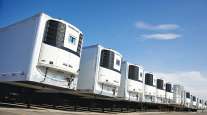Staff Reporter
Fleets’ Fuel Efficiency Rose in 2023, 2022: NACFE Study

[Stay on top of transportation news: Get TTNews in your inbox.]
Carriers’ fuel economy is on the rise after stagnating during a stretch from the 2010s into this decade, according to the results of a new North American Council for Freight Efficiency study.
Based on data from some of the North American freight industry’s largest carriers, fleet-wide fuel efficiency averaged 7.77 mpg in 2023, compared with 7.62 mpg in 2022. In 2013 the average was 6.67 mpg.
While some of the reported efficiency gains are tied to the mix of fleets reporting fuel economy data to NACFE, a larger share is due to individual fleets’ improvements in 2022 and 2023, the research and advocacy group said.
The 14 fleets participating in the study were: C.R. England, Frito-Lay, Hirschbach Motor Lines, Mesilla Valley Transportation, Nussbaum Transportation, Paper Transport, PepsiCo, Pilot Flying J, Pitt Ohio, Ryder System, Schneider National, UPS, Werner Enterprises and Wilson Logistics.
UPS ranks No. 1 on Transport Topics’ Top 100 list of the largest for-hire carriers in North America, Ryder ranks No. 6, Schneider ranks No. 9, Werner No. 16, C.R. England No. 42, Pitt Ohio No. 49, Hirschbach No. 55, Mesilla Valley No. 73 and Paper Transport No. 93.
NACFE noted that with the easing of the post-pandemic supply chain challenges, carriers have been able to restart their normal trade-in cycles, leading to newer, more fuel-efficient trucks and trailers in the study fleets.
The COVID-19 pandemic also led to operational challenges and increased idling time for trucks, thereby hurting the 2020 and 2021 figures, which set up favorable comparisons with 2022 and 2023, it added.
NACFE data show the five technologies with the largest growth rates in adoption in 2023 were predictive cruise control, minimum-gap fixed fifth wheel designs, high-efficiency alternators, two-speed/modulated cooling fan clutches and clutched air compressors.
Overall, the study encompasses 86 technologies that might improve fuel efficiency, including in the powertrain, chassis, aerodynamics of the tractor, cutting idling, tires and wheels, aerodynamics of the trailer and practices.
The overall adoption rate for fuel-saving technologies has grown from 17% in 2003 to 42% in 2023. And truck manufacturers continue to introduce advancements that can help fleets improve efficiency.
Lori Heino-Royer of Waabi discusses the latest developments, breakthroughs and key industry partnerships in autonomous trucking. Tune in above or by going to RoadSigns.ttnews.com.
New sleepers introduced in 2024 are key examples. Volvo Trucks North America is promising a 10% fuel efficiency enhancement on the redesigned VNL launched in January, while Daimler Truck North America is declaring the fifth iteration of its flagship Cascadia semi offers 35% better fuel economy than the debut model.
The study noted that a broader push among OEMs toward decarbonization may be slowing the rate of growth in diesel efficiency as truck manufacturers dedicate resources toward electric and fuel cell-powered tractors. But longer-term, NACFE Director of Emerging Technologies Rick Mihelic said that while engineers have initially focused on getting these products on the road, subsequent generations could see improvements as they take what they learn from the first trucks and develop enhancements.
NACFE also noted that a shift to regional haul and shorter routes is cutting fleets’ average mpg, with the amount of miles each vehicle racks up on a long-term downward trend as more goods are transported on shorter routes. This is a result, NACFE noted, of e-commerce growth plus fleet efforts to retain top drivers by tweaking routes to increase drivers’ time at home.
Those shorter routes, however, result in lower fuel efficiency as trucks spend a greater proportion of their day driving non-interstate routes and local roads. NACFE noted that, longer-term, this trend could eventually hurt fleets’ overall fuel economy and lead to an operational shift where the proportion of day cabs in the market would increase.
Want more news? Listen to today's daily briefing below or go here for more info:





